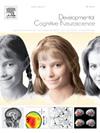How does SES influence the brain circuitry for literacy? Modeling the association between SES, oral language, white matter integrity, and reading
IF 4.9
2区 医学
Q1 NEUROSCIENCES
引用次数: 0
Abstract
Reading is pivotal for educational and occupational success, hence, understanding the factors contributing to reading skill variation is a major educational objective. Although cognitive and neurobiological factors that influence reading are well documented, the contributions of environmental factors, such as socioeconomic status (SES), fiv to reading-related neurobiology are relatively understudied. Studies have shown that SES predicts reading and the integrity of reading-related white matter tracts; however, the direct and indirect contributions of SES to reading via white matter integrity remain undifferentiated. Further, while oral language (both phonological awareness [PA] and vocabulary) has been positively associated with both SES and reading, only a few studies have attempted to model the SES-reading association via oral language, and none of them included white matter integrity. The current study closes these gaps by using Structural Equation Modeling in a large sample of children from the Healthy Brain Network biobank, testing the (in)direct paths by which SES (parental education) influences reading through oral language and white matter integrity. Results reveal an effect of SES on reading that is indirectly affected by oral language, though not by white matter integrity. These findings reinforce the role of oral language skills as a key pathway linking SES and reading.
SES如何影响读写能力的大脑回路?建立社会经济地位、口语、白质完整性和阅读之间的关联模型
阅读是教育和职业成功的关键,因此,了解影响阅读技能变化的因素是一个主要的教育目标。虽然影响阅读的认知和神经生物学因素已被充分记录,但环境因素,如社会经济地位(SES),对阅读相关神经生物学的贡献的研究相对较少。研究表明,SES可以预测阅读和阅读相关白质束的完整性;然而,SES通过白质完整性对阅读的直接和间接贡献仍然没有区分。此外,虽然口语(包括语音意识[PA]和词汇)与SES和阅读都有正相关,但只有少数研究试图通过口语来模拟SES和阅读的关联,而且没有一个研究包括白质完整性。目前的研究通过在健康大脑网络生物库的大量儿童样本中使用结构方程模型来弥补这些差距,测试了SES(父母教育)通过口头语言和白质完整性影响阅读的直接途径。研究结果显示,SES对阅读的影响间接受到口头语言的影响,但不受白质完整性的影响。这些发现强化了口语技能作为连接SES和阅读的关键途径的作用。
本文章由计算机程序翻译,如有差异,请以英文原文为准。
求助全文
约1分钟内获得全文
求助全文
来源期刊

Developmental Cognitive Neuroscience
NEUROSCIENCES-
CiteScore
7.60
自引率
10.60%
发文量
124
审稿时长
6-12 weeks
期刊介绍:
The journal publishes theoretical and research papers on cognitive brain development, from infancy through childhood and adolescence and into adulthood. It covers neurocognitive development and neurocognitive processing in both typical and atypical development, including social and affective aspects. Appropriate methodologies for the journal include, but are not limited to, functional neuroimaging (fMRI and MEG), electrophysiology (EEG and ERP), NIRS and transcranial magnetic stimulation, as well as other basic neuroscience approaches using cellular and animal models that directly address cognitive brain development, patient studies, case studies, post-mortem studies and pharmacological studies.
 求助内容:
求助内容: 应助结果提醒方式:
应助结果提醒方式:


